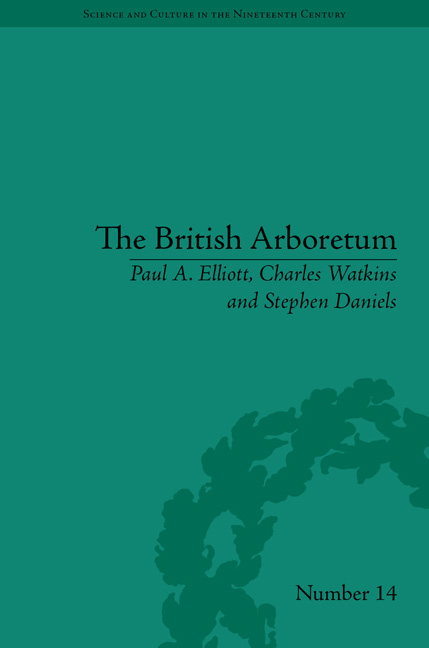Book contents
- Frontmatter
- CONTENTS
- List of Figures
- Preface
- Introduction
- 1 British Tree Cultures in the Nineteenth Century
- 2 Trees and Taxonomy
- 3 British Arboriculture, c. 1800–35
- 4 John Claudius Loudon's Arboretums
- 5 The Botany of the Arboretum Britannicum
- 6 The Derby Arboretum
- 7 Estate Arboretums
- 8 Public Urban Arboretums
- 9 The Transformation of Victorian Public Arboretums
- Conclusion
- Notes
- Works Cited
- Index
9 - The Transformation of Victorian Public Arboretums
- Frontmatter
- CONTENTS
- List of Figures
- Preface
- Introduction
- 1 British Tree Cultures in the Nineteenth Century
- 2 Trees and Taxonomy
- 3 British Arboriculture, c. 1800–35
- 4 John Claudius Loudon's Arboretums
- 5 The Botany of the Arboretum Britannicum
- 6 The Derby Arboretum
- 7 Estate Arboretums
- 8 Public Urban Arboretums
- 9 The Transformation of Victorian Public Arboretums
- Conclusion
- Notes
- Works Cited
- Index
Summary
Introduction
Public urban arboretums did not generally fulfil the original objectives of rational recreationists. Popularity, cost of maintenance and public clamour for access facilitated their decline as botanical educational institutions and they became increasingly indistinguishable from other urban leisure parks to an extent unanticipated by Loudon. This was reflected in demands for wider access, the abolition of privileged private subscriptions and the desire for municipal funding and control. The process was hastened by the success of special festivals, the demand for sports and recreational facilities and the provision of ponds, aviaries, lakes and other ornamental features. Public parks and arboretums became important centres for civic and patriotic display and communal feeling with processions and ceremonies, military events and the provision of imperial monuments and trophies. As we have seen, arboretums can be represented as idealized, objectivized collections akin to printed arboretums in arboricultural treatises, like laboratories. However, the reality was that they were fragile creations requiring constant maintenance and many utilized glass houses to lessen the impact of climatic and seasonal changes. Systematic botanical tree collections in urban areas presented special problems of maintenance and preservation, usually without the workforce and resources available on landed estates. The effort required to maintain significant public urban arboretum collections is evident from the well-documented difficulties that curators and staff had in accommodating the demands of public access, pollution and the encroachment of industrial and residential building.
- Type
- Chapter
- Information
- The British ArboretumTrees, Science and Culture in the Nineteenth Century, pp. 211 - 228Publisher: Pickering & ChattoFirst published in: 2014



